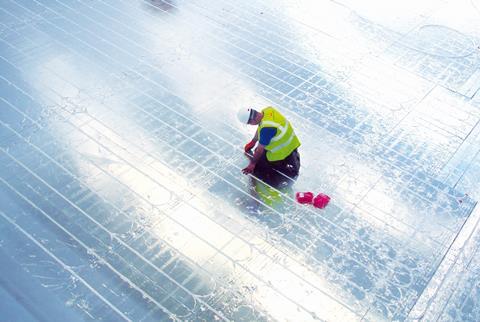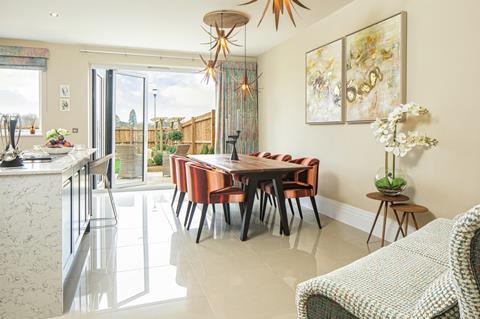This CPD, sponsored by WMS, will look at how underfloor heating works in practice, factors that can impact the use of such heating systems, the energy cost implications and installation.

CPD CREDITS: 60 MINUTES
DEADLINE: 21 JANUARY 2020
For more information about Assemble Media Group’s CPD distance-learning programme, click here

![WMS-LOGO-RED+(100%)-GREY-TICK-600x600 [light background use]](https://d3sux4fmh2nu8u.cloudfront.net/Pictures/280xAny/2/6/4/1880264_wmslogored100greytick600x600lightbackgrounduse_813525.jpg)
Introduction
Using underfloor heating can prove to be more energy effective in heating a room – whereby a large radiant floor surface area heats the space above it – than using convected heat provided by radiators which draws cold air across the floor before heating it. Using underfloor heating also enables designers to configure rooms to embrace features including floor-to-ceiling windows, allowing more light to flood into an internal space.
This CPD feature will look at how underfloor heating works in practice, factors that can impact the use of such heating systems, the energy cost implications and installation.
How underfloor heating works
By making the floor the warmest part of the room air cools as it rises, giving occupants heat where it is needed. This is also better for the environment since heat is not wasted through being lost from a building’s roof.
Underfloor heating works by circulating warm water through a series of continuous loops that are fitted underneath a floor, creating a large radiant surface that heats the room from the floor upwards. This radiant form of heating is more comfortable than the convected heat provided by radiators which draws cold air across the floor before heating it and then convects the warm air upwards towards the ceiling.

Healthier homes
In the UK an average one in eight people receive treatment for a respiratory condition such as asthma daily. Convection heating systems exacerbate this by encouraging the movement of dust and dust mites in the air. Since underfloor heating uses radiant heat this movement is reduced, providing a much healthier environment.
Convection heaters can be a magnet for dust particles and germs. Such units can be difficult to clean – behind them, underneath them or between the various components – and the amount of dirt which can build up can be problematic for some of a building’s occupants to be breathing in every day.
By its very nature underfloor heating is concealed which affords a freedom of design not only to configure furniture in a room but to accommodate full height windows more easily, increasing natural light into the building.
Government policy
Earlier this year the UK government announced plans to phase out gas-powered central heating as part of its proposed Future Homes Standard. This means that by 2025 all new homes built will have to adopt alternative means of keeping warm. No gas, basically. Electric radiators are not the answer due to the impact on annual running costs.
Indeed solely using electricity to heat a home can be very costly, average costs are around 13p/kWh with gas at an average 3.4p/kWh this translates to 382% more expensive to run .
And switching to a direct electricity source is unlikely to lead to significant efficiencies, since some systems offer less output than input. But an air source heat pump combined with an underfloor heating system will result in every 1kWh of electricity required producing a further 4 kWh (4.0 + coefficient of performance) of energy – which means it is 400% efficient.

Measuring heat pump efficiency
Heat pump efficiency is measured by its Coefficient of Performance (CoP), which shows how efficiently the ground and air source heat pump systems can heat your home under the best possible conditions. Using this scale, air source heat pump efficiency can be as high as 4, whereas ground source heat pumps can reach up to 5. This means that for every unit of electricity you put in, the heat pumps have the potential to produce 4 and 5 units of heat respectively.
To put this into perspective, electric heaters operate at around 100% efficiency (one unit of electricity produces one unit of heat), and even brand-new oil and gas boilers only function at an efficiency of around 90%.
There are several reasons why underfloor heating works more efficiently with renewable energy technology than radiators do.
First, heat is extracted from the external ambient air and utilised through the heat pump to warm the property. Even in the depths of winter there is enough heat outside for a heat pump to turn into energy, so in the UK heat pumps and UFH are a perfect partnership. Underfloor heating covers a greater surface area and can therefore run at lower temperatures – at 45 degrees C rather than 80 degrees C. The demand underfloor heating places on energy sources is therefore significantly less, making them ideal for use with heat pumps.
Both combined means the system is between 15 to 40 % cheaper to run.

Safety
One of the most common causes of burn injuries in a family home is from radiators (over 3,750 under-5s are admitted to hospital each year), ranking alongside hot liquids, hair straighteners and irons for common causes of burn injuries in young people and the elderly.
Underfloor heating is an obvious alternative to radiators, providing ‘hidden’ heat throughout a living space, which is easy and low cost to install, easy to maintain and also provides a more even distribution of heat than radiators.
Floor finishes
Tiles and stone floors can get very cold. Radiators only heat upwards from where they are installed so a floor is likely to remain cold and – in colder seasons – uncomfortable. With underfloor heating the whole floor essentially becomes one large radiator meaning with the floor finish can get warm throughout.
The Carpet Foundation carried out research with the Underfloor Heating Manufacturers Association, which saw five different carpet types and two different underlays tested over an underfloor heating installation in a test chamber which was 4m square by 3m high. The combined laboratory tested thermal resistance of these was in the range 2.6-3.4 tog.
The results showed that none of the carpet/underlay combinations interfered with the efficient warming of the airspace in the room above.
The findings suggested that carpet can be used over underfloor heating without impairing the performance of the system. This showed that a carpet/underlay with a combined thermal resistance of less than 2.5 togs allows underfloor systems to operate efficiently.
Using the correct pipework
The use of polyethylene pipework – preferably PE-RT, which stands for ‘polyethylene raised temperature’ – is recommended given that it has excellent strength properties under high pressure and temperatures as well as being very flexible and easy to use. It is non-corrosive and has very good resistance to frost. It is also creep-resistant and has a high impact strength, which means that if the pipe is distorted it will return to its original shape within a short period of time. RE- RT pipe is made of ethanol vinyl alcohol that prevents oxygen diffusion.
Oxygen diffusion is a very important factor within underfloor heating with the vast amount of pipework installed into the floors of every project, it is essential that the pipe has a very low level of oxygen permeability so that oxygen ingress cannot cause unnecessary damage and costs. A standard plastic pipe would not meet the required level of oxygen permeability.
Using environmentally safe pipe is obviously a must in today’s climate, unlike PEX pipework which has toxins in it that can only be burnt or buried due to the molecular cross-linking process, PE-RT pipe is completely environmentally friendly and can be easily melted and recycled.
Control
Control is a key element of underfloor heating, as it can make all the difference to the efficiency of the system. As UFH takes a longer time than radiators to heat up and cool down, this needs to be taken into account on the programming of the system. A 7-day programmable thermostat will maximise efficiencies and get the best out of your system, there are also upgrade options to be able to control the system from your smartphone/tablet.
System choice
Underfloor heating systems can be installed in all floor constructions, the most common method is to include the pipework within the floor screed build-up at the initial construction stage. But there are systems that also cater for joisted, structural, floating, low profile and even bespoke build-ups. A good UFH contractor will value engineer a particular system around the project build and ensure the performance specification is met if not exceeded.
Good design and installation are essential, but it is just as important to ensure that underfloor heating systems are properly balanced. Meticulous care and attention during balancing is vital if systems are to work efficiently and deliver the intended benefits. It is equally important that homeowners and residents are shown how to use their particular system and that they understand how to get the best from it.
It is likely that it will need to be operated in a different way from other heating systems to which residents may have become accustomed in the past. Settings may need to be different, and the heating may need to come on earlier and run for a longer period, albeit using less power than other systems. This aspect needs to be fully explained. Clearly the objective must be an effective and economic heating system that delivers trusted warmth for years to come.
Using a specialist UFH contractor who can offer complete project engineering at every stage, from bespoke project design, value engineering, complete system installation, balancing, testing and homeowners’ guides will give the most effective results for all concerned

How to take this module
Assemble Media Group’s CPD distance-learning programme is open to anyone seeking to develop their knowledge and skills. Each module also offers members of professional institutions an opportunity to earn between 30 and 90 minutes of credits towards their annual CPD requirement.
This article is accredited by the CPD Certification Service. To earn CPD credits, read the article and then click the link below to complete your details and answer the questions. You will receive your results instantly, and if all the questions are correctly answered, you will be able to download your CPD certificate straight away.
CPD CREDITS: 60 MINUTES
DEADLINE: 21 JANUARY 2020
Privacy policy
Information you supply to Assemble Media Group Limited may be used for publication and also to provide you with information about our products or services in the form of direct marketing by email, telephone, fax or post. Information may also be made available to third parties. Assemble Media Group Limited may send updates about Building CPD and other relevant Assemble Media Group Limited products and services. By providing your email address you consent to being contact by email, telephone, fax or post by Assemble Media Group Limited or other third parties. If at any time you no longer wish to receive anything from Assemble Media Group Limited or to have your data made available to third parties, contact the Data Protection Coordinator at building@building.co.uk. View our full privacy policy here




























No comments yet